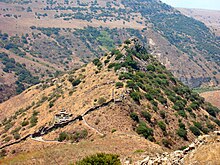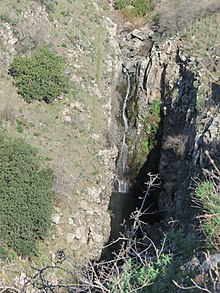Gamla
Coordinates: 32 ° 54 ′ 10 " N , 35 ° 44 ′ 26" E
Gamla (Hebrew גמלא Gamla or Gamala ) was from 87 BC. Chr. Until their destruction in 67 n. Chr. A significant Jewish town Gaulanitis (Today's Golan ). It is located 8 km east of the Sea of Galilee on a prominent hill.
Name and topography
The hill on which the city lay is shaped like a camel's hump. The name Gamla (Gamala) is derived from the Hebrew term gamal (camel). In the dialect of the Jewish population in that region, Gamala has been shortened to Gamla.
The picture on the right shows the location of the city. It covered a large part of the south-east sloping slope. The city covered an area of about 100 × 200 m. The synagogue was located near the city gate in the east of the city.
History of the city
Gamla is mentioned in the Talmud . That first mention by name probably refers to the Bronze Age (12th century BC). It was probably a fortified settlement. It was later destroyed and abandoned.
From around 538 BC. Jewish returnees from Babylonian exile settled on that hill and built a smaller town. This settlement was probably taken in the course of the conquests under Alexander the Great (approx. 332 BC).
In 87 BC The Hasmonean Alexander Jannaios founded the city anew. It was probably founded with the aim of being able to better defend that border region. The city was then named the provincial capital of the Jewish Golan region. As a result, Gamla became more important. It was arguably the most important spiritual center for conservative Jews in Judea across the Jordan . The city had a spacious synagogue (25.5 × 17 m) with a mikveh . The synagogue faced Jerusalem.
In the great Jewish war , the city sided with the Zealots . She chose to resist the Romans . After a long siege, it fell into the hands of the Romans in the winter of 67 AD. The Roman troops - under Vespasian - destroyed and sacked the city completely. It was never rebuilt and was forgotten. The ruins of the city were only rediscovered after the Six Day War .
Inhabitants and income base
Conservative Jews lived in the city, especially those of the Pharisaic faith . The archaeological findings prove this. Most of them were returnees from Babylonian exile .
The townspeople found their income mainly in the production and sale of olive oil. Large olive presses support this assumption. The city achieved a certain prosperity. Stately buildings and the discovery of luxury goods are evidence of this. At least four mikvehs (ritual baths) were available to the inhabitants .
In the first century AD the city had about 5000 inhabitants. When it was conquered by the Romans in AD 67, the city was home to even more people.
Resistance fighters
The city was also home to families who opposed foreign rule by the Romans and their vassals - such as the Herod dynasty . Members of the Zealot faction also lived in Gamla.
When Herod was the great governor of the province of Galilee, the rebel leader Hezekia from Gamla appeared (approx. 40 BC). Herod the Great fought the rebels and killed Hezekia.
Later, in the Jewish revolt after the death of Herod the Great, Hezekiah's son Judah appeared. This Judah had founded the resistance movement of the Sicarians (curved daggers). His resistance movement was instrumental in the uprising of the Jews of Sepphoris , the administrative seat of Herod the Great in Galilee (6/7 AD). It is likely that Judah was captured and executed by the Roman forces. The commander at that time was the governor of Syria , Publius Quinctilius Varus .
A descendant of the same family, Eleazar Ben Jair , was the leader in the resistance struggle of the Jews in Masada in AD 70.
National park
Gamla is now part of the Gamla Nature Reserve , an Israeli national park which, in addition to the ancient city, also includes an extensive natural area. Hiking trails lead past numerous dolmens to a high waterfall. Vultures are raised and released on the edge of the gorge.
Web links
literature
- Immanuel Benzinger : Gamala 1 . In: Paulys Realencyclopadie der classischen Antiquity Science (RE). Volume VII, 1, Stuttgart 1910, Col. 689 f.
Individual evidence
- ↑ Flavius Josephus, Jew. War IV, 5th
- ↑ Gamla: Jewish City on the Golan. In: Jewish Virtual Library. http://www.jewishvirtuallibrary.org/jsource/Archaeology/gamala.html
- ↑ The most important finds are in the Archaeological Museum in Katzrin, Golan.
- ↑ Josephus, Jüd. War IV: 1.1-81.
- ↑ Flavius Josephus, Jüd. Antiquities XIV, 158.
- ↑ Flavius Josephus, Jüd. Antiquities XVII, 271-272.


